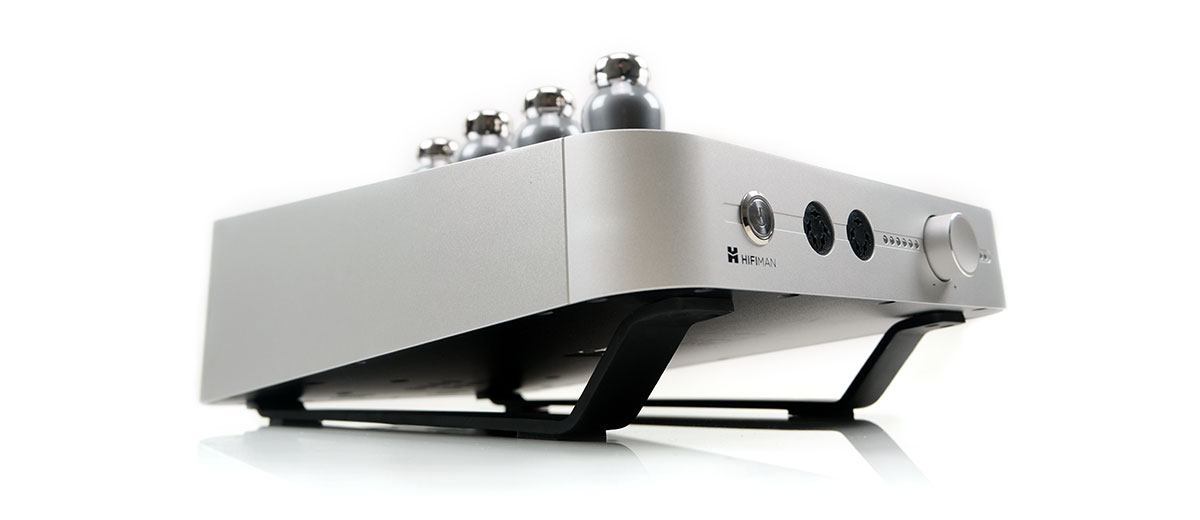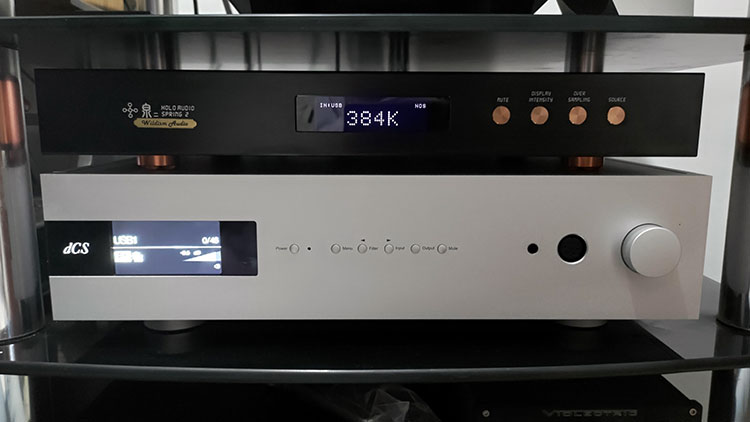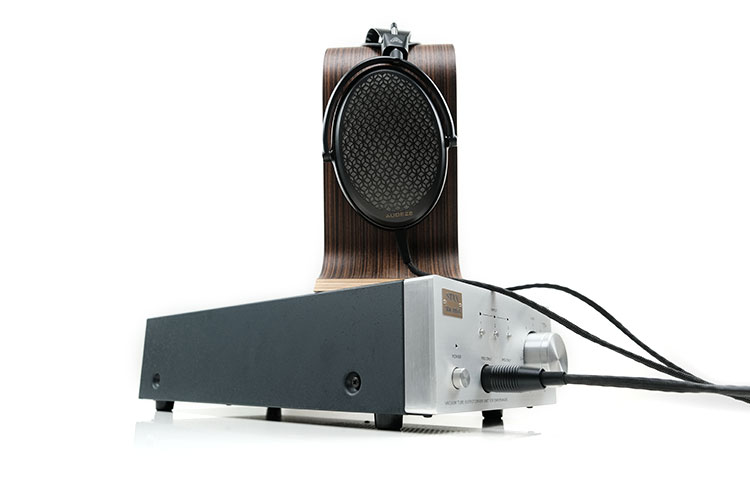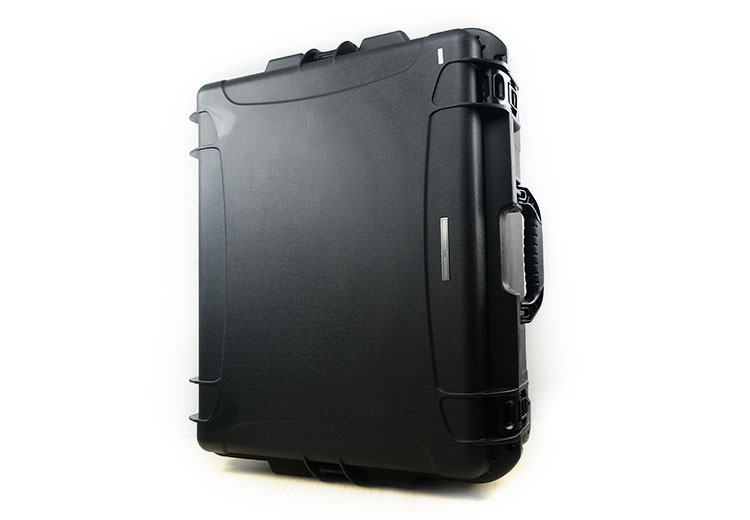Synergy
There are two areas I would pay careful attention to when setting up the Shangri-La Jr amplifier; the source and the headphones and how they speak to each other via the amp. For me, your choice of source will have a big effect on how appropriate the headphone pairing is with this amplifier.
Clean DACs
For example, the Chord Electronics Qutest is a clean, punchy, and articulate DAC but with a slight treble uptick. Paired with the Jr amp there is absolutely nothing wrong with that so long as the paired headphone is smooth and more to the relaxed side on the top-end. Otherwise, the resulting performance with brighter headphones can sometimes be a bit too clinical for my tastes.
In this instance, the warmer and fuller sounding Audeze CRBN felt a better pairing with this particular setup than the cleaner and more treble present Shangri-La Jr headphones. The CRBN’s beefier low-end and softer top-end is a perfect fit for the high-energy sound of the Qutest when paired with the Jr amp.
The Shangri-La Jr amp, in turn, sounded more mid-forward with the CRBN/Qutest than the neutral but more holographic sounding VE Enterprise E Lite amp. If rock vocals are your thing then this pairing performs quite well with some excellent PRaT to go along with it, an area that the Stax SRM-007tII amp is not as strong in.
R2R DACs
Connected to the very natural sounding Holo Spring DAC 2 or the Musician Audio Pegasus, two R2R DACs, the Shangri-La Jr amplifier is the perfect pairing for me with the Jr headphones and the punchy Stax SR-007MK2.
Both DACs offer a slightly more liquid tone that gels quite brilliantly with the Shangri-La Jr amplifier and the Jr headphone’s precise and articulate sound signature.
The Shangri-La Jr amplifier combined with the Holo Audio Spring DAC 2 sounds immaculate with a very black background and natural but clear instrumental timbre. Vocals have a very slight dissonance depending on the source mix but otherwise, the texture is excellent.
The Pegasus is close, perhaps slightly more neutral in low-end weight feeding into the Shangri-La Jr and you can pick up on that when doing the A/B with the Holo Spring DAC and both headphones. The Holo Spring 2 was the more resolving of the two R2R DACs with the Pegasus just marginally shrinking the staging potential of the Jr amp when compared side by side.
The Pegasus also has a slight diminution in the actual gain levels from its balanced input compared to the Holo Spring DAC which tends to force me to push up the dial a bit more on the Shangri-La Jr amplifier.
For the Stax 007MK2 headphones, this pairing also pushes down a little on its tendency to deliver a mildly metallic tone to its percussion timbre. You will get more of that harder-edged coloration with cooler DAC sources feeding the Jr amp, however.
Select Comparisons
All comparisons were tested using the HIFIMAN Shangri-La Jr Headphones, the Audeze CRBN, and a HOLO Audio Spring DAC 2 Wildism Edition DAC.
Stax SRM-007tII
$1730
We have never officially done a review of the SRM-007tII and though discontinued we thought it might provide a useful comparison to the more expensive Shangri-La Jr amplifier given it does share some electrical similarities.
Technical
The SRM-007tII is also a hybrid tube and solid-state desktop amplifier using a mix of 4 dual-triode 6FQ7(6CG7) tubes for its input and a solid-state dual FET input Class A output stage.
The Shangri-La Jr has a similar setup except with 4 custom 6SN7 tubes for its input and we presume a Class A for its output stage. Both tubes selections for each amp are the electrical equivalent of each other.
Beyond that comparative technical information is slim other than both offer balanced and unbalanced inputs and outputs with switching controls. However, the Stax has 2 dual RCA inputs and the switches are to the front whereas the Shangri-La Jr amplifier has a single SE dual RCA and the switch to the rear. I personally find switches to the front more user-friendly.
The two amps are Pro-Bias 580V compatible with dual 5-pin connectors to run two electrostatic headphones at the same time. Volume control is quite different on both, however. The Stax uses a smooth non-stepped attenuator with channel balance (rear part of the knob) and volume control functionality (front part of the knob).
The Shangri-La Jr is a relay-bass attenuator with a 24-step range and LED diodes to light up your volume level 2 steps at a time. It has none of the channel balancing functionality found on the Stax, however, its bias control is far more user-friendly at the bass compared to having to take the lid off on the Stax.
Design
The Stax is more compact, with a traditional shoebox format and weighing in at just under 5Kg (10.4lb). It can be stuffed into fairly tight spaces with enough room for venting those tubes fairly easily.
The Shangri-La Jr amplifier is much more of a statement piece in your system. It is uniquely shaped, beautifully designed with the tubes positioned front and center but much larger and heavier at 6.5kg. You will have to take more care protecting the Shangri-La Jr tubes whereas the Stax tubes are positioned inside a heavily vented chassis and well protected.
Other than a squishy rare switch button on the Shangri-La Jr amp, the quality of the finishing and the solid aluminum body materials used are excellent. More so than the Stax which has that thinner sheet metal and exposed screws behind the front panel that gives you a rather hollow echo when tapped.
You could argue that the tempered glass panel is a fingerprint magnet on the HIFIMAN amp but my personal experience is that it’s rarely touched during operation to be of major concern.
Performance
Despite not having anything concrete on paper, I suspect the Shangri-La Jr amplifier has a little bit more headroom and power compared to the SRM-007tII. With both up halfway on their dials, the HIFIMAN does sound the more dynamic and fuller sounding of the two amps using the Jr headphones.
Granted, you would expect the Jr headphones to sound just right with the matching headphone amp given it was tuned with this pairing in mind. However, I found that to be the same case also with the Audeze CRBN dynamics.
The SRM-007tII also has some tuning differences sounding a little more neutral in its staging depth with more treble energy and generally a flatter sound compared to the Shangri-La Jr amplifier’s juicier and fuller sounding performance. Vocals are a bit more to the fore sounding warmer and more rounded on the Jr amp and slightly lighter and cleaner on the Stax.
The choice of DAC does a lot more for the overall synergy of the pairings between each amplifier so we keep it the exact same with the natural sounding R2R Holo Audio Spring 2. Here, the 007tII sounded a little sweeter and not quite as bombastic on the low-end as the other two amplifiers.
The sweetness and peppier top-end worked really well with the CRBN which has a more relaxed treble tuning but with the Jr headphones, the smoother full-bodied tone of the Shangri-La Jr amplifier was the more enjoyable pairing.
The Stax amp felt a little ‘fizzier’ with the HIFIMAN headphone pairing on treble happy recordings though by no means a fatiguing listening experience. It’s a setup with simply a bit more focus on the mids and highs and less bass presence compared to the Shangri-La Jr amp.
Venture Electronics Enterprise E Lite
$2560
This has been one of my go-to electrostatic amplifiers for a few years now though not a particularly well-known one. It is priced lower than the Shangri-La Jr and aesthetically some way behind but its performance is competitive.
Technical
The Enterprise E Lite is a balanced 325Vrm capable hybrid amplifier. Internally, it uses a two-stage BJT Folded Cascode with CCS using two 6SN7GTB tubes similar to an older Stax SRM-T1 only with the CCS in place of the output resistors and BFT instead of JFET.
It also has a little opamp pre-amplification board, which amplifies the input signal before it goes into the potentiometer.
The Shangri-La Jr amplifier uses 4 customized 6SN7 tubes for its input and a Class A solid-state output so no opamp pre-amplification. However, the GTB version of the 6SN7 tubes use by the Enterprise light have a higher 450Vplate voltage rating compared to the 300v regular 6SN7 inside the HIFIMAN amp.
Though both are fully balanced the E Lite only offers balanced inputs with no capability to handle SE or dual RCA inputs. It also only has a single 580V Pro bias compatible 5-pin output compared to the dual 5-pin on the Shangri-La Jr amplifier. In terms of input complexity, the Shangri-La Jr is the more advance of the two.
Design
The Enterprise E Lite is very much the industrial looker sporting a utilitarian black angular large shoebox design. If you want an elegant electrostatic amplifier then the Shangri-La Jr is miles ahead in terms of looks. Its angular aluminum smooth curved design and the tempered glass top are miles ahead in terms of build quality.
That being said the E Lite is built like a tank with some very thick aluminum plates accented with heavy top panel grilling. The E Lite is also a much heavier amplifier at 9kg compared to the Shangri-La Jr’s 6.5kg.
The VE design does have plenty of screws to access and poke around underneath if that is your thing. I would argue that the E Lite is probably more serviceable as a result and indeed when cleaning the amp I can reach just about every internal with ease.
Performance
In terms of sheer power and headroom, the E Lite is an excellent performer with a pot control barely hitting 9 on the dial with Jr headphones and around 1-2 nuanced nudges higher for the CRBN.
Tonally, I would say the Shangri-La Jr amp is probably more tube-like in its delivery with a bit more warmth on the low-end and a slightly softer attack compared to the punchier and more precise sound of the Enterprise E Lite.
Both are hybrid amps but subjectively the E Lite leans a little more to the solid-state side of the equation with a slightly drier overtone and a bit more treble presence with both the CRBN and Jr headphone pairings.
The HIFIMAN does have a stronger mids presence with the CRBN compared to the neutral-sounding VE Enterprise E Lite. The Jr/CRBN combo vocals are a little further forward on the Jr amp and marginally more euphonic, and ‘fleshier’ sounding.
The E Lite was comparatively neutral in both midrange coloration and imaging though still not as sweet and light sounding as the SRM-007tII. It definitely has a more physical presentation compared to both competing amplifiers.
For personal preferences, the CRBN’s slightly softer fleshier tone works wonders with the E Lite’s more neutral timbre and tighter bass response. The Jr Headphones cleaner signature still references the better when paired with the matching Shangri-La Jr amp’s richer and smoother tuning.
Kingsound M20
$2500 (SRP) Street Price around $1500
Technical
Though the Kingsound M20 is also a tube-based electrostatic amplifier, internally, it is quite a different beast to the Shangri-La Jr. Instead of a two-stage tube input and solid-state Class A output, we instead have an Output Transformer-Less amplifier or an OTL design.
So, instead of a potentially expensive output transformer, Kingsound got rid of that with the OTL design and instead uses a capacitor to couple the tubes to the output. Supposedly OTL amps will offer more linearity and fidelity but that depends on how well it is implemented including the quality of the tubes chosen,
The tubes implementation is also a fair bit more complex on the M20 with two ECC83 high impedance amplifier triodes, (12AX7), four 6P15, and a single 6P6P (6V6) power tube. The Shangri-La Jr’s hybrid implementation keeps it simpler with a tube input stage only using the 4 6SN7 custom medium gain 300v variants. The output is a Class A solid-state operational mode.
The M20 is also a single-ended only amplifier so unlike the Shangri-La Jr it has no balanced output or a dual 5-pin pro bias connection option on the front. Volume control is just ok form on the M20, but its potentiometer for me is cruder and a bit noisier also physically.
Design
The M20 is more to the classic side of tube amplification design with a long pencil-like rectangular form factor and a grill guard over a recessed platform housing the 7 tubes. It is a relatively unusual and narrow design so needs a lot of depth on your rack but almost no width.
The Shangri-La Jr looks a lot classier, more modern, and clearly has the superior materials used in its construction. There are no exposed screws, smoother curving, and a more attractive angled aesthetic with that tempered glass on top. Its relay-based 24 step attenuator is a step up in quality over the basic low-resistance Alps-style pot used by the M20.
The Jr is the bigger of the two amps but weight-wise they are not that far apart at 5.2kg for the M20 and 6.5kg for the HIFIMAN. You will still need a lot more space for the Shangri-La Jr but given the design, it deserves its centerpiece credentials. The M20 needs space for the tubes but otherwise can be neatly tucked away in a corner.
Performance
The M20 is very much the tube sound signature with a lush, languid, and more euphonic overtone compared to the weightier tuning of the Shangri-La Jr amplifier. In terms of dynamics, I would give the edge to the Jr amplifier but you do have to remember the M20 is a single-ended topology so some SE 2V line-outs might sound a bit more placid, to begin with.
However, with a punchy DAC such as the Little Dot DAC VII or even the 2V line-out from the new FiiO M17, you can get a nice authoritative response. Otherwise, the Shangri-La Jr amp is the weightier sound with the stronger bass fundamental.
The M20 does have the softer pillowy low-end tuning with not quite as much depth when paired with both the CRBN and the Jr headphones. Midrange timbre and vocals are decidedly euphonic and creamy with the M20 but not quite as full-bodied as the Shangri-La Jr amplifier.
You get a more rounded and slightly forward vocal on the HIFIMAN amp but again I must emphasize DAC matching here as you can fatten up the M20 a bit with the Holo Audio Spring DAC whereas a cleaner Sabre DAC can produce a lighter but more polished timbre. on both amplifiers.
Neither of these amps delivers anything edgy on the top end. In fact, both are quite serene in their treble performances with only your source determining the final tone. If anything, the M20 is the slightly lighter of the two for note body in higher pitching treble percussion, and the Jr amp is a bit denser and smoother.
Our Verdict
The HIFIMAN Shangri-La Jr amplifier is an excellent performer with a wide range of electrostatic headphones. It excels in PRaT and bass extension with plenty of drive to deliver what I would define as a ‘big’ sound with a slightly rounded tone to its instrumental and vocal timbre.
Despite its hybrid topology, I would still consider this amp to side more with its tube topology than a neutral or dry solid-state sound. However, sources will have an effect on the performance which in turn might bring about a studied process in individual headphone pairings.
The short end of this story is the excellent Jr Headphones which maketh the system. With a natural-sounding DAC, they both sound dynamic and very detailed but importantly, not an overly bright and harsh sounding electrostatic timbre.
HIFIMAN Shangri-La Jr Amplifier Specifications
- 4 x 6SN7 vacuum tubes
- Relay-based attenuator with a 24-step level of volume control and 23 separate resistors
- Aviation-grade aluminum alloy, the advanced industrial design is from the HIFIMAN US design team in Boston
- Tempered glass top panel
- XLR balanced audio input and AUX source input port
- 2 Pro Bias 590V compatible headphone output ports
- AC 115V / 230V power selector
- Weight: 6.5kg (14.3lb)
- Dimensions: 276 x 270 x 116 mm³ (10.9″ x 10.6″ x 4.6″)






